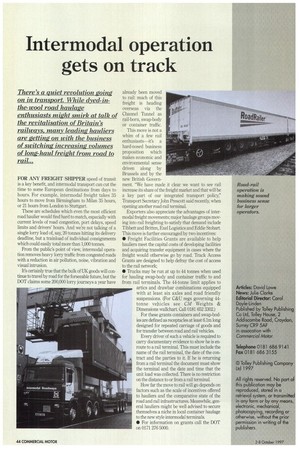Intermodal operation gets on track
Page 46

If you've noticed an error in this article please click here to report it so we can fix it.
FOR ANY FREIGHT SHIPPER speed of transit is a key benefit, and intermodal transport can cut the time to some European destinations from days to hours. For example, intermodal freight takes 35 hours to move from Birmingham to Milan 35 hours, or 21 hours from London to Stuttgart.
These are schedules which even the most efficient road haulier would find hard to match, especially with current levels of road congestion, port delays, speed limits and drivers' hours. And we're not talking of a single lorry load of, say, 20 tonnes hitting its delivery deadline, but a trainload of individual consignments which could easily total more than 1,000 tonnes, From the public's point of view, intermodal operation removes heavy lorry traffic from congested roads with a reduction in air pollution, noise, vibration and visual intrusion.
It's certainly true that the bulk of UK goods will continue to travel by road for the forseeable future, but the DOT claims some 200,000 lorry journeys a year have already been moved to rail: much of this freight is heading overseas via the Channel Tunnel as rail-born, swap-body or container traffic. This move is not a whim of a few rail enthusiasts—it's a hard-nosed business proposition which makes economic and environmental sense driven along by Brussels and by the new British Govern ment. "We have made it clear we want to see rail increase its share of the freight market and that will be a key part of our integrated transport policy," Transport Secretary John Prescott said recently, when opening another road-rail terminal.
Exporters also appreciate the advantages of intermodal freight movements; major haulage groups mov ing into rail freighting to satisfy that demand include Tibbett and Britten, Exel Logistics and Eddie Stobart This move is further encouraged by two incentives: • Freight Facilities Grants are available to help hauliers meet the capital costs of developing facilities and acquiring transfer equipment in cases where the freight would otherwise go by road. Track Access Grants are designed to help defray the cost of access to the rail network; • Trucks may be run at up to 44 tonnes when used for hauling swap-body and container traffic to and from rail terminals, The 44-tonne limit applies to artics and drawbar combinations equipped with at least six axles and road friendly
suspensions. (For CU regs governing 44tonne vehicles see CM Weights & Dimensions wallchart. Call 0181 652 3302.)
For these grants containers and swap-bodies are defined as receptacles at least 6.1m long designed for repeated carriage of goods and for transfer between road and rail vehicles.
Every driver of such a vehicle is required to carry documentary evidence to show he is enroute to a rail terminal. This must include the name of the rail terminal, the date of the contract and the parties to it. If he is returning from a rail terminal the document must show the terminal and the date and time that the unit load was collected. There is no restriction on the distance to or from a rail terminal.
How far the move to rail will go depends on factors such as the scale of incentives offered to hauliers and the comparative state of the road and rail infrastructures, Meanwhile, general hauliers might be well advised to secure themselves a niche in local container haulage to the new style intermodal terminals.
• For information on grants call the DOT on 0171 276 5000.








































































































